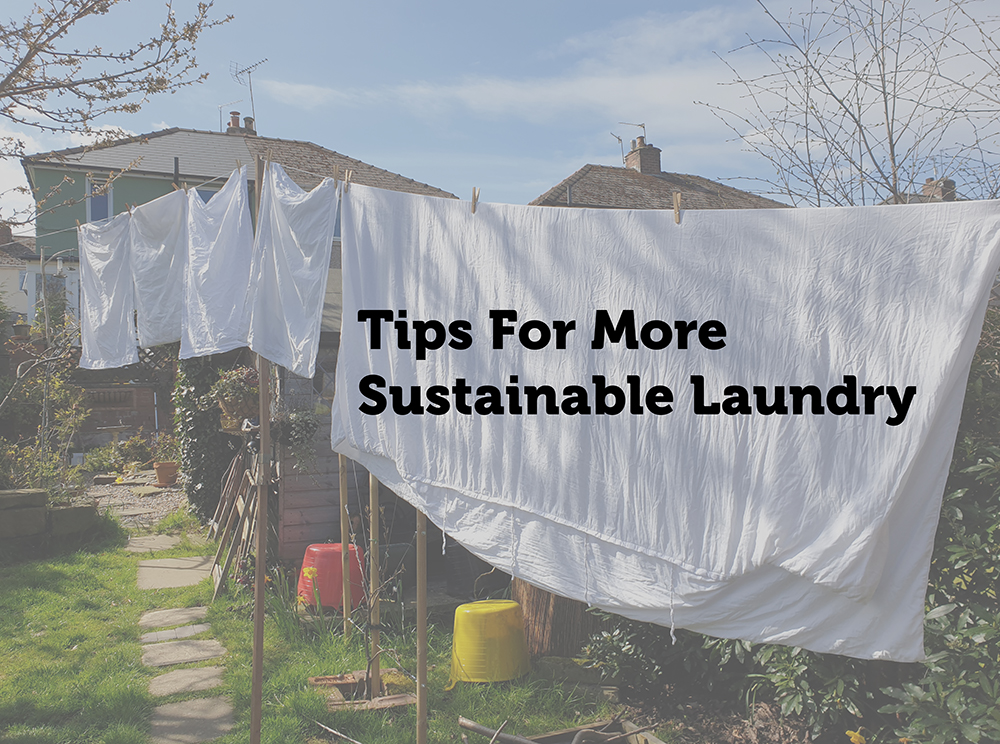
Loved clothes last. How we launder our clothes and textile goods and how long we keep them in active use are key to how sustainable we can make them. It’s a stage in an item’s lifecycle which can be the most damaging to the environment and over which we are completely in control, so your good decisions really can have an impact. Making things ourselves using thoughtfully sourced materials is no good if we then; never use it, discard it if it gets damaged or wash it at high temperatures and shove it in the tumble dryer every time we do use it.
Here is some simple advice for loving and lengthening the life of all your textile items, be they clothes or home textiles, bought readymade or made by you. It might also save you some money too.
Washing:
You don’t need to wash an item every time it has been used. A quick spritz with water with a few drops of essential oil and hanging it outside on the line can be enough to refresh an item.
When you do need to put on a load of washing, these simple tips will help to reduce its environmental impact AND save you some money:
- Use soda crystals instead of detergent. This is one of my secret weapons, it’s way cheaper than laundry detergent and can also help to clean and maintain your washing machine at the same time as doing your laundry! You can completely replace your regular laundry detergent with soda crystals or add some to your usual detergent (roughly 50/50). If you live in a hard water area and don’t have a water softener, soda crystals can also help to soften hard water and reduce limescale build-up in your washing machine.
- Use white vinegar instead of fabric conditioner. Another of my secret weapons! Just pop it in the fabric conditioner compartment of your washing machine and again, it’s a lot cheaper than fabric conditioner and won’t leave an oily coating on your fabric (which is how fabric conditioner works). White vinegar is brilliant at getting rid of odours – it works better than anything else I’ve used on sweat – and no it won’t leave your laundry smelling of vinegar. Like soda crystals, vinegar will also help to soften your water if you live in a hard water area. To add a nice scent to your laundry, just add a few drops of essential oil to the vinegar.
- Try to keep similar fibre content fabrics together in your sewing projects to make laundering easier and more effective.
- Always use a washing temperature of 30 degrees or less. Modern laundry detergents are formulated to work well at lower temperatures, soda crystals and white vinegar will also work at 30. Then choose a gentle wash cycle, both these choices will reduce damage to fibres, maintain colours and generally prolong the life of your textile items.
- Close all fastenings when you put items in the wash so they can’t snag fabric.
- Unless an item is particularly dirty, wash inside out, it reduces pilling and damage to the fabric’s surface.
- Place delicate items such as underwear and tights in a mesh laundry bag – you could always make your own using the instructions in the “Push the Envelope” project in my book How to Sew Sustainably – just make an unlined version in mesh, voile or muslin.
- Don’t tumble dry, line dry outside and when that’s not possible, dry on an airer indoors. To avoid condensation and increased humidity invest in a dehumidifier, honestly our dehumidifier revolutionized my winter laundry!
Fabric Pre-Washing & Shrinkage:
If you do buy new fabric, pre-wash it as soon as you get it home. Many fabrics will either shrink or lose some colour the first time they are washed.
Here is a rough guide to how much different fibres might shrink on that first wash:
- Synthetic fabrics (eg. polyester, nylon) shouldn’t shrink at all.
- Cotton fabrics (especially knitted fabrics) are likely to shrink by up to 10%.
- Linen is likely to shrink by 5-10%.
- Viscose / rayon / bamboo can shrink by up to 8%.
- Wool can shrink by as much as 15%.
Shrinkage tends to occur most along the length of fabric and knits tend to shrink more than wovens as there is more movement in the structure of knitted fabric.
Here is a guide to how best to wash different fibres:
- most synthetics can be washed on a 30 degree regular cycle (although they are good at absorbing odours, my vinegar tip above can help reduce this),
- cotton can be washed on a 30 degree regular cycle,
- wool needs a cool (below 30 degrees) gentle wash with minimum agitation,
- viscose / rayon / bamboo should be washed on a cool (below 30 degrees) gentle wash,
- silk can be very gently machine washed at 20-30 degrees or carefully hand washed with minimum agitation.
Like clothes, fabrics are best dried outside on the line, but if this isn’t possible, knitted fabrics should be dried flat (to prevent them from stretching out of shape) and woven fabrics can be hung to dry on an airer. TIP: don’t drape your fabrics over prominent shapes such as chair backs or banisters, they’ll stick into your fabric and stretch and distort the area draped over them. The resulting mis-shaped areas are difficult to flatten out later.
Pressing:
Pressing is not ironing. Pressing requires a different technique to ironing, when pressing you need to apply varying amounts of pressure and heat in small areas, whereas ironing is maintaining a constant light pressure whilst moving the iron over large areas.
Try and get in the habit of pressing every seam once you have stitched it. This is known as “pressing as you go” and it makes any sewing that comes afterwards neater.
A few tips and reminders for successful pressing:
- Always press on the wrong side of the fabric.
- Use a bit of steam to speed up and improve the finish of your pressing.
- Synthetic fibre fabrics need to be pressed at low temperatures, too high and the iron can leave a “shine” on the fabric or it can melt
- Natural fibre fabrics can take higher temperatures, especially cotton, linen and wool. The exception is silk which must be pressed on a low temperature.
- If you need to press the right side of the fabric use a pressing cloth (find out more about pressing cloths in this post).
- When pressing interfaced areas use a pressing cloth as the interfacing can still melt if caught with a too-hot iron.
- Don’t press over pins, they can leave pin holes in your fabric and some plastic bead heads can melt.
- Remove tacking before pressing as it can leave permanent marks.
Happy wash day!! If you have any more tips that I’ve missed or you have had success with any of the tips here, do share your experiences in the comments.




















Nailed it with the fabric point! Really essential laundry tip!
LikeLike
Lovely. Both the curated tips and the concept of the post.Thank you so much for curating it. If yo dont mind I would like to add a couple of ideas known to me. I prep bio enzymes and they work great for laundry. THe bio enzymes is made from rottern /discarded fruits from nearby store. Even soapnuts are a very eco friendly method of washing clothes. in my country people use it to wash naturally dyed fabrics too. Of course this cant become a global option as it depends on availability.nHave a great day
LikeLike
Thanks so much for these additional tips!! I’ve heard of soapnuts, I’m going to read up about them again now that you’ve reminded me. Do you buy the enzymes from your nearby store or do you extract them yourself? It sounds like a specialist process.
LikeLike
I always struggle with the part about drying yardage flat – I often buy 3m+ at a time, and there’s nowhere flat in my house that can accommodate that amount of fabric in one layer. Do you normally fold it, or is there another trick to this? At the moment I tumble dry most of my yardage – mainly for this reason, but also in case other members of the household accidentally put my me-made clothes in the drier months down the line!
LikeLike
You can get airers that open out with a flat section or ones that fit over the bath. I often fold fabric and place it on these and keep refolding to get it all dry.
LikeLike
I might give that a go then, thank you!
LikeLike
I already use vinegar (haven’t used fabric conditioner for many many years), but didn’t know I could just use soda crystals instead of detergent. Going to try it out thank you. I do use them though in an occasional short hot cycle without clothes to clean the machine.
LikeLike
They work really well. Even added to detergent if you want to start reducing the amount of detergent you use, plus the added bonus of cleaning your machine with every wash!!
LikeLike
A good read, very useful tips on sustainable clothing and doing our part for keeping the environment safe. I definitely wants to try the soda crystals and white vinegar in my laundry! Thank you!
LikeLike
Thank you.
They definitely work!! Particularly good on smelly gym gear 😆
LikeLike
Just added soda crystals and white vinegar to my shopping list.
Quick question, does embroidey cotton wash ok for visible mending I’m a bit nervous about it pulling the repair out of shape.
LikeLike
Good question but I think the process of dyeing embroidery thread would mean it’s pre-shrunk and colour fast. If you’re particularly concerned do a test sample though. Also make sure the fabric you’re sewing onto is pre-shrunk and colour fast. All the mends I’ve recently done using embroidery thread have been through a regular machine wash and are fine 👍🪡
LikeLike
Thank you
LikeLiked by 1 person